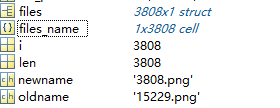目录:
1.进行批量文件名的重置
2.sort_net 解决dir顺序问题
3.关于元胞数组的读取
1.进行批量文件名的重置
clear;
clc;
files = dir(strcat('F:\2019\','*.PNG'));
len=length(files);
for i=1:len
oldname=files(i).name;
newname=strcat(num2str(i),'.png')
% eval(['!rename' 32 oldname 32 newname]);
command = ['rename' 32 oldname 32 newname];
status = dos(command);
if status == 0
disp([oldname, ' 已被重命名为 ', newname])
else
disp([oldname, ' 重命名失败!'])
end
end
值得注意的时,本文件需要和你重置名称的图片放在一个文件夹底下。否则会出现“系统文件不存在”的错误。
2.sort_nat 解决dir顺序问题
由于在上述代码中,如果你的批量图片名存在为:1.png;2.png;…1001.png;…1010.png.你会发现在用dir读取的files.name的特性中,排序放式并不是你想要的1,2,,,这种方式,而是1,1001,1010,…,2,…这种方式。
所以为了能够按十进制的排序方式,采用sort_nat()函数,对files.name 进行排序。其中调用sort_nat()方式和sort_nat()函数内容如下。
%调用sort_net()
clear;
clc;
files = dir(strcat('F:\2019春\课题总结实验1\未改进代码\InverseHalftoning-master\train_color\cmyk\train\raw\','.PNG'));
files_name =sort_nat({files.name})
len=length(files);
for i=1:len
oldname=files_name{i};
newname=strcat(num2str(i),'.png')
eval(['!rename' 32 oldname 32 newname]);
end
这里值得注意的时是函数的调用方式是files_name =sort_nat({files.name}),而不是files_name =sort_nat(files.name),否则会出报错为错误使用 sort_nat,输入参数太多。”
%sort_nat具体内容
function [cs,index] = sort_nat(c,mode)
%sort_nat: Natural order sort of cell array of strings.
% usage: [S,INDEX] = sort_nat(C)
%
% where,
% C is a cell array (vector) of strings to be sorted.
% S is C, sorted in natural order.
% INDEX is the sort order such that S = C(INDEX);
%
% Natural order sorting sorts strings containing digits in a way such that
% the numerical value of the digits is taken into account. It is
% especially useful for sorting file names containing index numbers with
% different numbers of digits. Often, people will use leading zeros to get
% the right sort order, but with this function you don't have to do that.
% For example, if C = {'file1.txt','file2.txt','file10.txt'}, a normal sort
% will give you
%
% {'file1.txt' 'file10.txt' 'file2.txt'}
%
% whereas, sort_nat will give you
%
% {'file1.txt' 'file2.txt' 'file10.txt'}
%
% See also: sort
% Version: 1.4, 22 January 2011
% Author: Douglas M. Schwarz
% Email: dmschwarz=ieee*org, dmschwarz=urgrad*rochester*edu
% Real_email = regexprep(Email,{'=','*'},{'@','.'})
% Set default value for mode if necessary.
if nargin < 2
mode = 'ascend';
end
% Make sure mode is either 'ascend' or 'descend'.
modes = strcmpi(mode,{'ascend','descend'});
is_descend = modes(2);
if ~any(modes)
error('sort_nat:sortDirection',...
'sorting direction must be ''ascend'' or ''descend''.')
end
% Replace runs of digits with '0'.
c2 = regexprep(c,'\d+','0');
% Compute char version of c2 and locations of zeros.
s1 = char(c2);
z = s1 == '0';
% Extract the runs of digits and their start and end indices.
[digruns,first,last] = regexp(c,'\d+','match','start','end');
% Create matrix of numerical values of runs of digits and a matrix of the
% number of digits in each run.
num_str = length(c);
max_len = size(s1,2);
num_val = NaN(num_str,max_len);
num_dig = NaN(num_str,max_len);
for i = 1:num_str
num_val(i,z(i,:)) = sscanf(sprintf('%s ',digruns{i}{:}),'%f');
num_dig(i,z(i,:)) = last{i} - first{i} + 1;
end
% Find columns that have at least one non-NaN. Make sure activecols is a
% 1-by-n vector even if n = 0.
activecols = reshape(find(~all(isnan(num_val))),1,[]);
n = length(activecols);
% Compute which columns in the composite matrix get the numbers.
numcols = activecols + (1:2:2*n);
% Compute which columns in the composite matrix get the number of digits.
ndigcols = numcols + 1;
% Compute which columns in the composite matrix get chars.
charcols = true(1,max_len + 2*n);
charcols(numcols) = false;
charcols(ndigcols) = false;
% Create and fill composite matrix, comp.
comp = zeros(num_str,max_len + 2*n);
comp(:,charcols) = double(s1);
comp(:,numcols) = num_val(:,activecols);
comp(:,ndigcols) = num_dig(:,activecols);
% Sort rows of composite matrix and use index to sort c in ascending or
% descending order, depending on mode.
[unused,index] = sortrows(comp);
if is_descend
index = index(end:-1:1);
end
index = reshape(index,size(c));
cs = c(index);
3.关于元胞数组的读取
在上述利用了sort_nat()函数之后,你的files.name 以元胞数组的格式读取进来。即为:
所以:
oldname=files_name(i)不能以数组的形式调用它,而是oldname=files_name{i}以元胞数组的形式调用。
参考:
https://ww2.mathworks.cn/matlabcentral/fileexchange/10959-sort_nat-natural-order-sort
https://blog.csdn.net/me4weizhen/article/details/53199488
https://www.ilovematlab.cn/thread-221007-1-1.html
https://www.ilovematlab.cn/thread-472310-1-1.html
https://jingyan.baidu.com/article/ca00d56c19d041e99eebcfdf.html






















 2826
2826











 被折叠的 条评论
为什么被折叠?
被折叠的 条评论
为什么被折叠?








